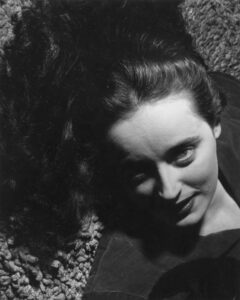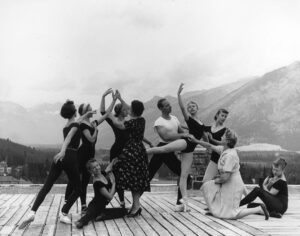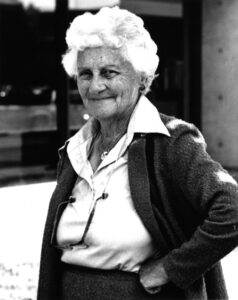GWENETH LLOYD
1901-1993
A PAGE IN HISTORY
BIOGRAPHY
Born: 1901, Eccles, Yorkshire, England
Died: 1993, Kelowna, British Columbia, Canada
Gweneth Lloyd began social and fancy dancing at age thirteen. She loved to dance and was determined to make it her career. She attended the Liverpool Physical Training College and during her first teaching job she reconnected with movement when she became interested in Ruby Ginner’s Revived Greek Dance. Historian Anna Blewchamp argues that it was the emphasis on expressivity and musicality in the Revived Greek Dance that characterized Lloyd’s choreography. In 1924, Lloyd left her job to study with Ginner full time. She complemented this training by studying Cecchetti and RAD ballet technique eventually becoming an examiner for the RAD. In 1926, Lloyd and a colleague opened a school in Leeds where she befriended a student named Betty Hey (later Farrally). The two immigrated to Canada settling in Winnipeg in 1938. Betty was 23, Gweneth, 36.
Upon their arrival, the pair opened the Canadian School of Ballet. There was an ample supply of dance teachers in Winnipeg in 1938, but Lloyd and Farrally wanted to contribute more than yet another training facility. They realized that to really foster ballet’s development in their new prairie home, they needed to educate potential audience members. Within months of their arrival, they initiated the Winnipeg Ballet Club and offered free tuition to anyone accepted; they also held monthly lecture-demonstrations open to the public. They soon connected with a dynamic jack-of-all-trades named David Yeddeau. This “holy trinity”, so called by later Royal Winnipeg Ballet artistic director Arnold Spohr, formed an unstoppable team that brought ballet to new heights in Canada. Lloyd was the choreographer, Farrally the rehearsal director and Yeddeau added experience in set design and construction, wardrobe and make-up, and stage management.
Following the performance programming developed by impresarios such as Serge Diaghilev, Lloyd decided she would create programmes that offered a mixture of white ballets, comic ballets along with a taste of the avant-garde. Anna Blewchamp describes Lloyd’s process in The Encyclopedia of Theatre Dance in Canada, “Lloyd was one of few choreographers who could visualize complete works before she began rehearsals. She would listen to the music and write her ballets, sometimes with casts of over twenty dancers, with musical measures noted against her own personal notation of descriptions, ballet, national and Greek dance terminology, floor plans and figure drawings.” Lloyd created truly Canadian ballets using Canadian themes in such works as Grain (1939), Kilowatt Magic (1939), The Shooting of Dan McGrew (1950) and Shadow on the Prairie (1952); using Canadian designers such as Robert Bruce (Dionysos, 1945) and Joseph Plaskett (Visages, 1949); and using Canadian composers such as Walter Kaufmann (Visages) and Robert Fleming (Shadow on the Prairie).
In 1948, the “holy trinity”, along with Toronto teacher/choreographer Boris Volkoff, initiated the Canadian Ballet Festivals. The six festivals, presented in various Canadian cities between 1948 and 1954, brought a new popularity to ballet in Canada. The chief goal was to create an environment in which Canadian dancers could earn a living in their own country. This goal was reached in 1951 when Winnipeg Ballet dancers began receiving a small wage. Later that same year, the National Ballet of Canada made its debut. By 1952, dancers were making a living performing on television in Toronto and Montreal, and later Vancouver. By 1957, the Canada Council had formed and was funding the Royal Winnipeg Ballet, the National Ballet of Canada and Montreal-based Les Grands Ballets Canadiens.
Mixed in with all of this activity was Lloyd’s work establishing a ballet department at the Banff School of Fine Arts. She initiated a ballet program within the Theatre Division in 1947; ballet became its own division in 1957. By the time Gweneth Lloyd left Banff in 1967, she and Farrally had resettled in Kelowna, British Columbia, having opened a new branch of the Canadian School of Ballet. Lloyd received numerous awards for her contribution to Canadian culture including the Order of Canada in 1969 and the Governor-General’s Performing Arts Award for Lifetime Achievement just months before she died in 1993.
CONTENTS
The entire portfolio contains many items related to Betty Farrally.
BOX 1 Choreographic Notes
- Notes from workshops attended 1951-1953
- Choreographic notes from Winnipeg Ballet, Canadian School of Ballet (Winnipeg and Kelowna), individual notebooks for each work, dating from 1949-1978 with most works dated in the 1960s and 1970s
BOX 2 Photographs, RAD Fellowship, Class/Choreographic Notes
- Photographs: Winnipeg Ballet (1940s), Royal Winnipeg Ballet (early 1950s), The Banff Centre (1950s, 1960s, some snap shots c. 1985), personal snap shots, Canadian School of Ballet (Kelowna, BC)
- Royal Academy of Dancing Fellowship
- Various slides
- Class and choreographic notes
BOX 3 RAD Gazette, Music Scores, Realia
- Magazines: The Dancing Times (issues primarily from 1960s including special supplement about the RAD in Canada); Dance Gazette (issues primarily from 1960 and 1970s), RAD Annual Reports (primarily 1970s)
- Music Scores: Introspection by Robert Fleming (1960), Swan Lake pas de trois, Don Quixote pas de deux, Sleeping Beauty “Bluebird” pas de deux
- Realia: costume jewellery, eyeglasses and cases, pens, initialed brush
BOX 4 House and Souvenir Programmes and Personal Materials
- Royal Winnipeg Ballet souvenir programmes, 1952-1978 (incomplete)
- Souvenir programmes from other dance companies including Les Grands Ballets Canadiens, The Royal Ballet, Moiseyev Dance Theatre, Korean Folk Dance Company, The Bolshoi Ballet
- Banff School of Fine Arts brochures and programmes, 1957-1988 (incomplete)
- Unpublished manuscript, “Next class, please”, biography of Gweneth Lloyd by Esme Crampton
BOX 5 Lloyd / Farrally Personal
- Correspondence (including Mauryne Allan, Banff Centre, Banff Centre students and faculty, BC Premier Bill Bennett, Donald Cameron, Agnes De Mille, David Earle, Jennifer Penney, Royal Winnipeg Ballet, Mother Teresa)
- Notebook from tribute evening in honour of Betty Farrally, signed by Brian Macdonald, David Earle, Annette av Paul and René Highway among others, July 29, 1983, Farrally Hall, The Banff Centre
- Award documents (Diplôme d’honneur, Royal Bank Award, Order of Canada)
- Eulogy for Mara McBirney by Mauryne Allan
- Correspondence and photos regarding sponsored child in India
- Obituaries, articles, letters of condolence following Betty Farrally’s death (1989)
BOX 6 Audio Tapes
- 1/4 inch reel-to-reel audio tapes of music for a variety of works taught at the Canadian School of Ballet and the Banff School of Fine Arts (1970s)
BOX Box 7 Books
- See DCD’s library list
BOX Box 8 Books
- See DCD’s library list
BOX Box 9 Photographs
- Original and photocopied photographs from various Winnipeg Ballet productions including The Wager, Finishing School, Arabesque, Rondel, Kaleidoscope, Through the Looking Glass, Chapter 13, The Shooting of Dan McGrew, Ballet Premiere, Ballet Composite, Intermede
- Original and photocopied portrait photographs of Winnipeg Ballet artists including Marilyn Young, Gordon Wales, Richard Rutherford, Sonia Taverner, Joan Chasney, Arnold Spohr, Jean Stoneham, Jean McKenzie, Betty Farrally, Gweneth Lloyd, Bill McGrath, Marina Katronis, Carlu Carter, Joan Anderson
- Obituaries for Gweneth Lloyd and David Yeddeau
- Lawrence Adams’ notes about Gweneth Lloyd
- Transcript from “The Dance”, CBC Radio, interview by William Littler with Gweneth Lloyd, September 17, 1978
- Photocopies of magazine clippings, 1940s
CROSS REFERENCES
PORTFOLIOS
- David Adams Portfolio, Aida Alberts Electronic Archives, Josephine Andrews Portfolio, Anna Blewchamp Portfolio, Carlu Carter Portfolio, Jean McKenzie Portfolio, Arnold Spohr Electronic Archives, Gordon Wales Portfolio
ORAL HISTORY
- Oral History Collection (Gweneth Lloyd interviewing U.S. choreographer Martha Graham),
- Painting of set design for Dionysos by Robert Bruce
BOOKS
- Blewchamp, Anna. 2000. “Betty Farrally”. In Susan Macpherson, ed. Encyclopedia of Theatre Dance in Canada/Encyclopédie de la Danse Théâtrale au Canada. Toronto: Dance Collection Danse Press/Presse. ISBN: 0-929003-42-X
- Blewchamp, Anna. 2000. “Gweneth Lloyd”. In Susan Macpherson, ed. Encyclopedia of Theatre Dance in Canada/Encyclopédie de la Danse Théâtrale au Canada. Toronto: Dance Collection Danse Press/Presse. ISBN: 0-929003-42-X
- Crabb, Michael. 2003. An Instinct for Success: Arnold Spohr and the Royal Winnipeg Ballet. Toronto: Dance Collection Danse Press/Presse. ISBN: 0-929003-45-4
- Wyman, Max. 2000. “Royal Winnipeg Ballet”. In Susan Macpherson, ed. Encyclopedia of Theatre Dance in Canada/Encyclopédie de la Danse Théâtrale au Canada. Toronto: Dance Collection Danse Press/Presse.ISBN: 0-929003-42-X
WORKS
Works choreographed for the Winnipeg Ballet (Source: Wyman, Max. 1978. The Royal Winnipeg Ballet: The First Forty Years. Toronto: Doubleday. ISBN: 0-385-14009-6.)
- Kilowatt Magic (1939), Bedrich Smetana
- Grain (1939), unknown
- Divertissements (1940), Piotr Ilyich Tchaikovsky
- The Wager (1940), Wolfgang Amadeus Mozart
- Beauty and the Beast (1940), Barbara Pentland
- Triple Alliance (1941), various
- Backstage 1897 (1941), Alexander Glazunov
- Les Preludes (1941), Franz Liszt
- Façade Suite (1941), William Walton
- The Wise Virgins (1942), Johann Sebastian Bach
- Finishing School (1942), Johann Strauss
- Queen of Hearts (1942), Joseph Haydn
- Through the Looking Glass [later known as Alice] (1942), Deems Taylor
- Ballet Blanc (1942), Anton Arensky
- An American in Paris (1943), George Gershwin
- The Planets (1943), Gustav Holst
- Russalki (1943), Mikhail Glinka
- Etude (1943), Fréderic Chopin
- Kaleidoscope (1945), traditional
- Les Coryphées (1945), Piotr Ilyich Tchaikovsky
- Dionysos (1945), Sergei Rachmaninov
- Pleasure Cruise (1946), Jacques Ibert and Dmitri Shostakovich
- Arabesque I (1947), Robert Schumann
- Object Matrimony (1947), Franz Schubert
- Concerto (1947), Sergei Rachmaninov
- Chapter 13 (1947), originally George Gershwin, rescored by Robert Fleming in 1948
- Allegory (1948), César Franck
- Visages (1949), Walter Kaufmann
- Arabesque II (1949), Alexander Glazunov
- Slavonic Dance (1949), Walter Kaufmann\
- Romance (1949), Alexander Glazunov
- The Rose and the Ring (1949), Walter Kaufmann
- The Shooting of Dan McGrew (1950), Eric Wild
- Rondel (1951), Antonio Vivaldi
- Shadow on the Prairie (1952), Robert Fleming
PERSONNEL
Miriam Adams, C.M.
Co-founder/Advisor
Amy Bowring
Executive and Curatorial Director
Jay Rankin
Administrative Director
Vickie Fagan
Director of Development and Producer/Hall of Fame
Elisabeth Kelly
Archives and Programming Coordinator
Michael Ripley
Marketing & Sales Coordinator
CONTACT
1303 – 2 Carlton St.
Toronto, ON
M5B 1J3
Canada
Phone: 416-365-3233
Fax: 416-365-3169
info [AT] dcd.ca
HOURS
Mon. – Fri. 10 a.m. – 5 p.m.
Appointment Required
Contact our team by email or call one of the numbers above












